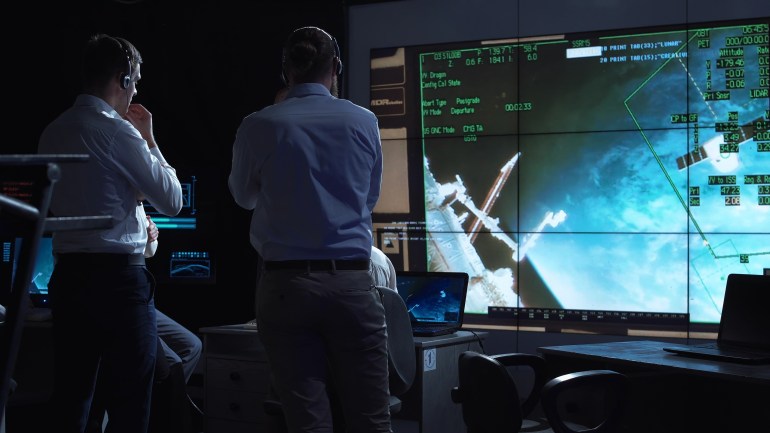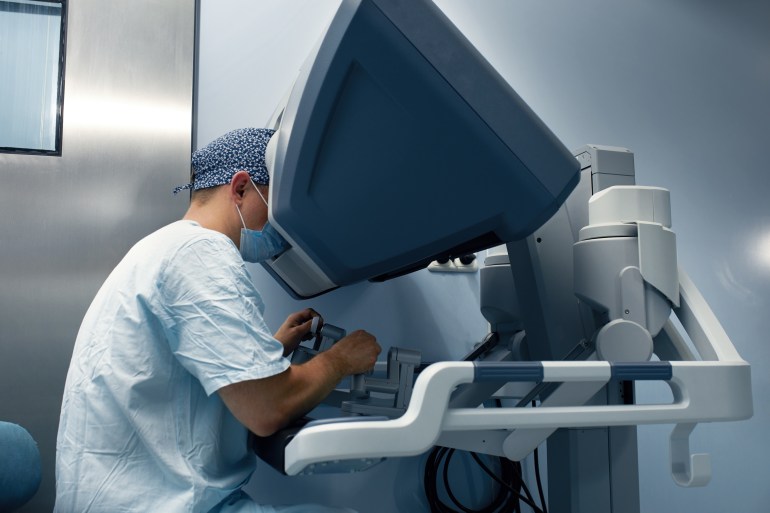Surgeons around the world perform nearly 300 million surgical operations each year, according to the World Health Organization. As of the beginning of 2023, approximately 11 million surgeries were conducted using surgical robots. Hospitals globally are estimated to have about 7,500 surgical robots.
These robots assist surgeons in a variety of operations, particularly dangerous ones that require extreme precision, such as brain tumor removals, retinal, and heart surgeries.
It's worth mentioning that currently used surgical robots are not automated—meaning the surgeon fully controls the operation while the robot adds enhanced "precision" and "safety".
The increasing reliance on surgical robots raises several questions: Do robotic surgeries truly offer a relative advantage compared to traditional surgeries, and what are the current developments these robots are undergoing?

NASA has endeavored to develop a means to treat injuries in space.
Innovative Ideas… Unfinished Projects
Accuracy was not the only driving force behind the development of the surgical robot. In the 1970s, NASA sought to develop a means to treat astronauts' injuries and illnesses using surgical devices mounted in space stations, controlled by surgeons from Earth—a concept known as "tele-surgery".
The U.S. Defense Advanced Research Projects Agency (DARPA) adopted the same principle, attempting to develop technologies to treat war injuries and casualties directly on the battlefield. However, both projects' efforts did not reach fruition.
With the continuous development in communications, surgeons Jacques Marescaux and Michel Gagner conducted the first tele-surgery to remove a gallbladder, treating a patient in Strasbourg, France, from their location in New York.
Despite the procedure's success, the concept of remote surgery did not achieve its desired spread due to the lag between the doctor's decision and the movement of the electronic tool.

In 1985, Dr. Yik San Kwoh performed neurosurgery in the brain using an electronic arm.
Reliance on Robots… Not a New Idea
The history of robot assistance in surgeries dates back to 1985 when Dr. Yik San Kwoh conducted precise neurological surgery to take a brain biopsy using a "robotic arm" alongside computed tomographic imaging.
The procedure involved using tomographic imaging to locate the target area, then transferring the data to the robotic arm beside the patient's head, which precisely pinpointed where the biopsy should be taken, allowing the operation to be performed safely and accurately.
The next development phase began in the 1990s with the emergence of endoscopic surgeries, which can be described as a magnifying scope that aids the doctor in performing surgeries through limited intervention without making large surgical incisions.
At the end of the last century, doctors developed the "da Vinci" surgical system, which heavily relies on robots to perform surgeries where the surgeon sits behind a console looking at a screen, controlling surgical instruments with joysticks, which means that the decision is up to the surgeon, and the robot handles the execution.

The development of robotic surgery does not always mean it is the best.
Surgeons and Patients… Benefiting from Robots
Between the marketing hype to promote the incorporation of robots in surgical procedures and the real benefit from this reliance, numerous researchers have conducted many studies trying to determine the gains from utilizing robots.
One study found that reliance on robots generally promotes healing after surgery. Another confirmed that using surgical robots for colorectal cancer surgeries achieves safer results compared to endoscopic and open surgeries, as robots reduce the risks of bleeding and infection.
However, this study noted two weaknesses associated with robot reliance: longer surgery duration and higher costs.
Continuing comparisons between robotic and traditional endoscopic surgeries, one study found that results of treating endometriosis via both methods were similar.
Another study explained that endoscopic surgeries for the removal of certain female reproductive system cancers reduced bleeding and were faster compared to robotic surgery, yet, the surgical robots helped surgeons remove more tumors.
In 2021, a review of 50 randomized trials indicated that robotic surgeries did not make a difference in outcomes compared to open or endoscopic surgeries.
A 2018 study found that minimally invasive laparoscopic or robotic interventions did not contribute to the healing of cervical cancer in women compared to open surgery, and the U.S. Food and Drug Administration warned against using robots for mastectomy operations.
In a "The New York Times" report, surgeon Naila Danani, the lead author of a study titled "The Evidence Behind Robot-Assisted Internal Surgeries", said, "There's no reason for patients to choose robotic surgery over any other technique, as having advanced technology doesn't always mean it is the best."
The study showed robotic surgeries were safe and outperformed their counterparts in 4 types of surgeries, while no difference occurred in another 46 surgeries.
The use of surgical robots extends to complex dental surgeries, as in 2016, the FDA approved robot use for dental implant procedures.

Researchers are developing micro-robots thinner than a single hair strand to deliver medications to very specific areas of the body for treating conditions, notably cancer.
The Surgical Robot… Under Continuous Development
In January 2022, Johns Hopkins University scientists successfully performed a fully automated robotic surgery on animal intestinal tissues without surgeon intervention, with the robot masterfully stitching the intestine's ends.
The study's lead author, Axel Krieger, said the surgery was conducted on four animals and resulted in better outcomes compared to those performed by surgeons.
Researchers aspire to automate some surgeries to maximize patient safety. Nevertheless, there are concerns, as these robots somewhat resemble self-driving cars that can navigate autonomously under ideal conditions, such as an obstacle-free straight road. Similarly, with the human body—despite its general uniformity, each body has specific attributes that make it distinct from others.
In further developments, researchers are now working on micro-robots, even thinner than a single hair strand, aiming to deliver certain medications to extremely targeted body areas to treat diseases, most importantly, cancers.
A research team at the University of California, San Diego, managed to introduce a micro-robot inside a test mouse's stomach to deliver a dose of gold nanoparticles before the robot self-destructed.
Robotic surgeries remain under constant development, with health institutions worldwide, including the Arab region, aiming to increase their reliance on them to improve various surgical outcomes for patients and facilitate the operations for surgeons. The coming years are expected to witness significant advancements in this field.


